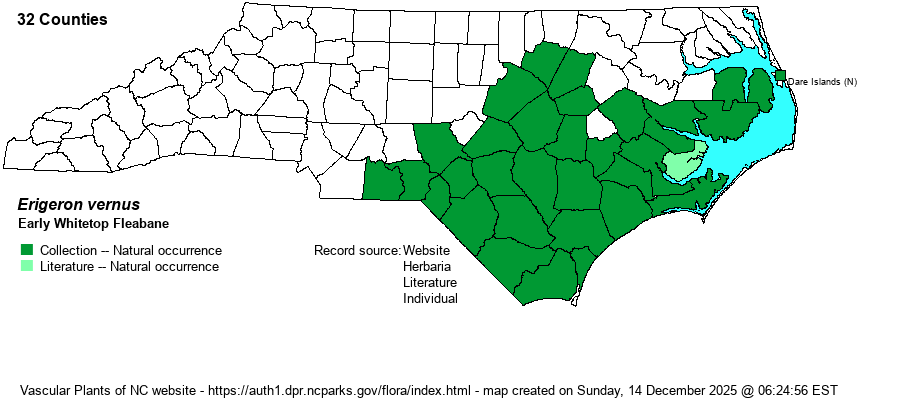| Author | (L.) Torrey & A. Gray | |
| Distribution | Coastal Plain and Sandhills; rare on the Outer Banks (Roanoke Island only). Absent from the northern Coastal Plain. Could occur in the northern counties, as it is known from several southeastern VA counties. Very rare in the Piedmont, at Pee Dee NWR in a unique flatwoods-like site.
Southeastern VA to southern FL and LA. | |
| Abundance | Fairly common to locally common in the southern half of the Coastal Plain and Sandhills. Infrequent in the central counties. | |
| Habitat | This is a wetland species; moist to wet Longleaf Pine-Wiregrass savannas and flatwoods, blackwater streamhead ecotones, pitcher-plant seepage bogs, and other sites with moist acidic soils. |
| Phenology | Flowering and fruiting Late March-June. | |
| Identification | Early Whitetop Fleabane grows from a rosette of thick-textured, dark green, elliptic to obovate basal leaves. Stems grow mostly 8 inches to 1.5 feet tall, and stem leaves are few and very small, giving the plant a "naked stem" look. Heads are rather large for a fleabane, with numerous long and broad white rays and dull yellow disks. Small rosettes can look somewhat like those of Venus Flytrap (Dionaea muscipula) at first glance, especially as this fleabane is often quite common in pine savannas where the much scarcer flytraps grow. | |
| Taxonomic Comments | None
| |
| Other Common Name(s) | Whitetop Fleabane | |
| State Rank | S5 | |
| Global Rank | G5 | |
| State Status | | |
| US Status | | |
| USACE-agcp | OBL link |
| USACE-emp | OBL link |

